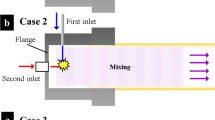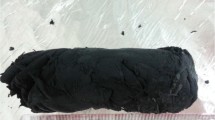Abstract
Hollow cylindrical carbon nanotube (CNT) sock was synthesized via floating catalyst chemical vapor deposition. The synthesis process was carried out in a horizontal furnace by injecting feedstock consisting of ethanol, ferrocene, thiophene, and deionized water into the alumina tube with argon as carrier gas. In order to investigate the formation mechanism of the hollow cylindrical CNT sock, the influence of the injection rate and C/Fe molar ratio of feedstock on the nucleation and growth of CNTs was discussed. The products were characterized using X-ray diffraction, scanning electron microscopy, transmission electron microscopy, Raman spectroscopy, and thermo-gravimetric analysis. The results showed that hollow cylindrical CNT sock was obtained when those two parameters were 30 ml h−1 and 523, respectively. A deposition-float-assembly (D-F-A) formation mechanism was proposed for the formation of CNTs sock. Firstly, the as-prepared CNTs were deposited on the inner surface of the alumina tube. Secondly, with the help of buoyant effect for Fe catalyst nanoparticles, CNTs floated in the alumina tube with longer length. The long CNTs were assembled into interconnected CNT membranes. The alumina tube was blocked by the accumulation of CNT membranes to form a self-closing system. The CNT sock was obtained by drawing out the block stably. The D-F-A formation mechanism is of great significance in the fabrication of the hollow cylindrical CNT sock.








Similar content being viewed by others
References
Alemán B, Ranchal R, Reguero V, Mas B, Vilatela JJ (2017) Carbon nanotube fibers with martensite and austenite Fe residual catalyst: room temperature ferromagnetism and implications for CVD growth. J Mater Chem C 5:5544–5550
Delord B, Neri W, Bertaux K, Derre A, Ly I, Mano N, Poulin P (2017) Carbon nanotube fiber mats for microbial fuel cell electrodes. Biores Technol 243:1227–1231
Yuan Y, Liu Z, Zhang K, Han W, Chen J (2018) Nanoscale welding of multi-walled carbon nanotubes by 1064 nm fiber laser. Opt Laser Technol 103:327–329
Zhang XS, Yang LW, Liu HT, Zu M (2018) Mechanical and electrical properties of direct spun carbon nanotube fibers exposed to ultrahigh temperatures in vacuum. J Nanosci Nanotechnol 18:4264–4269
Zhang SC, Kang LX, Wang X, Tong LM, Yang LW, Wang ZQ, Qi K, Deng SB, Li QW, Bai XD, Ding F, Zhang J (2017) Arrays of horizontal carbon nanotubes of controlled chirality grown using designed catalysts. Nature 543:234–238
Lee J, Oh E, Kim T, Sa JH, Lee SH, Park J, Moon D, Kang IS, Kim MJ, Kim SM, Lee KH (2015) The influence of boundary layer on the growth kinetics of carbon nanotube forests. Carbon 93:217–225
Li QW, Zhang XF, DePaula RF, Zheng LX, Zhao YH, Stan L, Holesinger TG, Arendt PN, Peterson DE, Zhu YT (2006) Sustained growth of ultralong carbon nanotube arrays for fiber spinning. Adv Mater 18:3160–3163
Lu Z, Chao Y, Ge Y, Foroughi J, Zhao Y, Wang C, Long H, Wallace GG (2017) High-performance hybrid carbon nanotube fibers for wearable energy storage. Nanoscale 9:5063–5071
Kou L, Huang T, Zheng B, Han Y, Zhao X, Gopalsamy K, Sun H, Gao C (2014) Coaxial wet-spun yarn supercapacitors for high-energy density and safe wearable electronics. Nat Commun 5:3754
Allahbakhsh A, Bahramian AR (2015) Self-assembled and pyrolyzed carbon aerogels: an overview of their preparation mechanisms, properties and applications. Nanoscale 7:14139–14158
Janas D, Koziol KK (2016) Carbon nanotube fibers and films: synthesis, applications and perspectives of the direct-spinning method. Nanoscale 8:19475–19490
Xiang R, Hou B, Einarsson E, Zhao P, Harish S, Morimoto K, Miyauchi Y, Chiashi S, Tang Z, Maruyama S (2013) Carbon atoms in ethanol do not contribute equally to formation of single-walled carbon nanotubes. ACS Nano 7:3095–3103
Ding F, Harutyunyan AR, Yakobson BI (2009) Dislocation theory of chirality-controlled nanotube growth. Proc Natl Acad Sci USA 106:2506–2509
Liu B, Tang DM, Sun C, Liu C, Ren W, Li F, Yu WJ, Yin LC, Zhang L, Jiang C, Cheng HM (2011) Importance of oxygen in the metal-free catalytic growth of single-walled carbon nanotubes from SiO(x) by a vapor-solid-solid mechanism. J Am Chem Soc 133:197–199
Mikhalchan A, Fan Z, Tran TQ, Liu P, Tan VBC, Tay T-E, Duong HM (2016) Continuous and scalable fabrication and multifunctional properties of carbon nanotube aerogels from the floating catalyst method. Carbon 102:409–418
Wang S, Liu Q, Li M, Li T, Gu Y, Li Q, Zhang Z (2017) Property improvements of CNT films induced by wet-stretching and tension-heating post treatments. Compos A Appl Sci Manuf 103:106–112
Wang YJ, Li M, Gu YZ, Zhang XH, Wang SK, Li QW, Zhang ZG (2015) Tuning carbon nanotube assembly for flexible, strong and conductive films. Nanoscale 7:3060–3066
Wang JN, Luo XG, Wu T, Chen Y (2014) High-strength carbon nanotube fibre-like ribbon with high ductility and high electrical conductivity. Nat Commun 5:3848
Liu P, Tan YF, Hu DCM, Jewell D, Duong HM (2016) Multi-property enhancement of aligned carbon nanotube thin films from floating catalyst method. Mater Des 108:754–760
Hoecker C, Smail F, Pick M, Boies A (2017) The influence of carbon source and catalyst nanoparticles on CVD synthesis of CNT aerogel. Chem Eng J 314:388–395
Li YL, Kinloch IA, Windle AH (2004) Direct spinning of carbon nanotube fibers from chemical vapor deposition synthesis. Science 304:276–278
Gspann TS, Smail FR, Windle AH (2014) Spinning of carbon nanotube fibres using the floating catalyst high temperature route: purity issues and the critical role of sulphur. Faraday Discuss 173:47–65
Motta MS, Moisala A, Kinloch IA, Windle AH (2008) The role of sulphur in the synthesis of carbon nanotubes by chemical vapour deposition at high temperatures. J Nanosci Nanotechnol 8:2442–2449
Cheng HL, Koh KLP, Liu P, Thang TQ, Duong HM (2015) Continuous self-assembly of carbon nanotube thin films and their composites for supercapacitors. Colloids Surf A Physicochem Eng Asp 481:626–632
Shah KA, Tali BA (2016) Synthesis of carbon nanotubes by catalytic chemical vapour deposition: a review on carbon sources, catalysts and substrates. Mater Sci Semicond Process 41:67–82
Pattinson SW, Prehn K, Kinloch IA, Eder D, Koziol KKK, Schulte K, Windle AH (2012) The life and death of carbon nanotubes. RSC Adv 2:2909–2913
Kang CS, Lee IJ, Seo MS, Kim SH, Baik DH (2017) Effect of purification method on the electrical properties of the carbon nanotube fibers. Fibers Polym 18:1580–1585
Boncel S, Sundaram RM, Windle AH, Koziol KK (2011) Enhancement of the mechanical properties of directly spun CNT fibers by chemical treatment. ACS Nano 5:9339–9344
Li YL, Zhang LH, Zhong XH, Windle AH (2007) Synthesis of high purity single-walled carbon nanotubes from ethanol by catalytic gas flow CVD reactions. Nanotechnology 18:225604
Qiu J, Terrones J, Vilatela JJ, Vickers ME, Elliott JA, Windle AH (2013) Liquid infiltration into carbon nanotube fibers: effect on structure and electrical properties. ACS Nano 7:8412–8422
Banks CE, Crossley A, Salter C, Wilkins SJ, Compton RG (2006) Carbon nanotubes contain metal impurities which are responsible for the “electrocatalysis” seen at some nanotube-modified electrodes. Angew Chem Int Ed 45:2533–2537
Cheng HM, Li F, Su G, Pan HY, He LL, Sun X, Dresselhaus MS (1998) Large-scale and low-cost synthesis of single-walled carbon nanotubes by the catalytic pyrolysis of hydrocarbons. Appl Phys Lett 72:3282–3284
Mercier G, Hérold C, Marêché J-F, Cahen S, Gleize J, Ghanbaja J, Lamura G, Bellouard C, Vigolo B (2013) Selective removal of metal impurities from single walled carbon nanotube samples. N J Chem 37:790
Motta M, Moisala A, Kinloch IA, Windle AH (2007) High performance fibres from ‘dog bone’ carbon nanotubes. Adv Mater 19:3721–3726
Cheng H, Koh KLP, Liu P, Thang TQ, Duong HM (2015) Continuous self-assembly of carbon nanotube thin films and their composites for supercapacitors. Colloids Surf A 481:626–632
Jung Y, Song J, Huh W, Cho D, Jeong Y (2013) Controlling the crystalline quality of carbon nanotubes with processing parameters from chemical vapor deposition synthesis. Chem Eng J 228:1050–1056
Cunha R, Paupitz R, Yoon K, Van Duin ACT, Elias AL, Carozo V, Dasgupta A, Fujisawa K, Lopez NP, Araujo PT, Terrones M (2018) Raman spectroscopy revealing noble gas adsorption on single-walled carbon nanotube bundles. Carbon 127:312–319
Liu P, Fan Z, Mikhalchan A, Tran TQ, Jewell D, Duong HM, Marconnet AM (2016) Continuous carbon nanotube-based fibers and films for applications requiring enhanced heat dissipation. ACS Appl Mater Interfaces 8:17461–17471
Gspann TS, Juckes SM, Niven JF, Johnson MB, Elliott JA, White MA, Windle AH (2017) High thermal conductivities of carbon nanotube films and micro-fibres and their dependence on morphology. Carbon 114:160–168
Sundaram RM, Windle AH (2017) One-step purification of direct-spun CNT fibers by post-production sonication. Mater Des 126:85–90
Hou GF, Chauhan D, Ng V, Xu CH, Yin ZZ, Paine M, Su RT, Shanov V, Mast D, Schulz M, Liu YJ (2017) Gas phase pyrolysis synthesis of carbon nanotubes at high temperature. Mater Des 132:112–118
Lee SH, Park J, Kim HR, Lee J, Lee KH (2015) Synthesis of high-quality carbon nanotube fibers by controlling the effects of sulfur on the catalyst agglomeration during the direct spinning process. RSC Adv 5:41894–41900
Sundaram RM, Koziol KK, Windle AH (2011) Continuous direct spinning of fibers of single-walled carbon nanotubes with metallic chirality. Adv Mater 23:5064–5068
Tibbetts GG, Bernardo CA, Gorkiewicz DW, Alig RL (1994) Role of sulfur in the production of carbon fibers in the vapor phase. Carbon 32:569–576
Kim MS, Rodriguez NM, Baker RTK (1993) The interplay between sulfur adsorption and carbon deposition on cobalt catalysts. J Catal 143:449–463
Conroy D, Moisala A, Cardoso S, Windle A, Davidson J (2010) Carbon nanotube reactor: ferrocene decomposition, iron particle growth, nanotube aggregation and scale-up. Chem Eng Sci 65:2965–2977
Zhang R, Zhang YY, Wei F (2017) Horizontally aligned carbon nanotube arrays: growth mechanism, controlled synthesis, characterization, properties and applications. Chem Soc Rev 46:3661–3715
Acknowledgements
This work is supported by the National Nature Science Foundation of the People’s Republic of China (Nos. 51572243 and 51872262).
Author information
Authors and Affiliations
Corresponding author
Ethics declarations
Conflict of interest
The authors declare no conflict of interest. The funders had no role in the design of the study; in the collection, analyses, or interpretation of data; in the writing of the manuscript; or in the decision to publish the results.
Additional information
Publisher's Note
Springer Nature remains neutral with regard to jurisdictional claims in published maps and institutional affiliations.
Electronic supplementary material
Below is the link to the electronic supplementary material.
Rights and permissions
About this article
Cite this article
Jiang, M., Ou, G., Ma, R. et al. Deposition-float-assembly formation mechanism of continuous hollow cylindrical carbon nanotube sock via floating catalyst chemical vapor deposition. J Mater Sci 54, 6961–6970 (2019). https://doi.org/10.1007/s10853-019-03378-y
Received:
Accepted:
Published:
Issue Date:
DOI: https://doi.org/10.1007/s10853-019-03378-y




